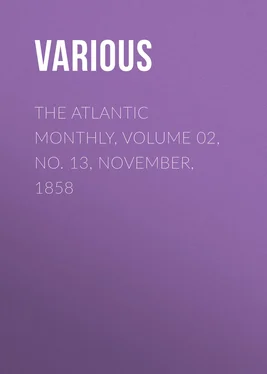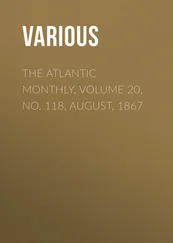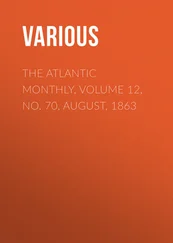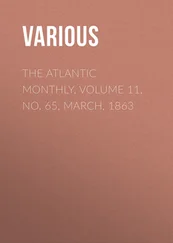Various - The Atlantic Monthly, Volume 02, No. 13, November, 1858
Здесь есть возможность читать онлайн «Various - The Atlantic Monthly, Volume 02, No. 13, November, 1858» — ознакомительный отрывок электронной книги совершенно бесплатно, а после прочтения отрывка купить полную версию. В некоторых случаях можно слушать аудио, скачать через торрент в формате fb2 и присутствует краткое содержание. Жанр: foreign_antique, periodic, foreign_edu, на английском языке. Описание произведения, (предисловие) а так же отзывы посетителей доступны на портале библиотеки ЛибКат.
- Название:The Atlantic Monthly, Volume 02, No. 13, November, 1858
- Автор:
- Жанр:
- Год:неизвестен
- ISBN:нет данных
- Рейтинг книги:4 / 5. Голосов: 1
-
Избранное:Добавить в избранное
- Отзывы:
-
Ваша оценка:
- 80
- 1
- 2
- 3
- 4
- 5
The Atlantic Monthly, Volume 02, No. 13, November, 1858: краткое содержание, описание и аннотация
Предлагаем к чтению аннотацию, описание, краткое содержание или предисловие (зависит от того, что написал сам автор книги «The Atlantic Monthly, Volume 02, No. 13, November, 1858»). Если вы не нашли необходимую информацию о книге — напишите в комментариях, мы постараемся отыскать её.
The Atlantic Monthly, Volume 02, No. 13, November, 1858 — читать онлайн ознакомительный отрывок
Ниже представлен текст книги, разбитый по страницам. Система сохранения места последней прочитанной страницы, позволяет с удобством читать онлайн бесплатно книгу «The Atlantic Monthly, Volume 02, No. 13, November, 1858», без необходимости каждый раз заново искать на чём Вы остановились. Поставьте закладку, и сможете в любой момент перейти на страницу, на которой закончили чтение.
Интервал:
Закладка:
In the case of railroads, as of other labor-saving (and labor-producing) contrivances, the innovation has been loudly decried; but though it does render some classes of labor useless, and throw out of employment some persons, it creates new labor for more than the old, and gives much more than it takes away.
Twenty years of experience show that the diminished cost of transport by railroad invariably augments the amount of commerce transacted, and in a much larger ratio than the reduction of cost. It is estimated by Dr. Lardner that three hundred thousand horses, working daily in stages, would be required to perform the passenger-traffic alone which took place in England during the year 1848.
Regarding the safety of railroad-travelling, though the papers teem with awful calamities from collisions and other causes, yet so great is the number of persons who use the new mode of transport, that travelling by railroad is really about one hundred times safer than by stage. The mortality upon English roads was for one year observed: —one person killed for each sixty-five million transported; in America, for the same time, one in forty-one million.
If we should try to reason from the rate of past railway-growth as to what the future is to be, we should soon be lost in figures. Thus, in the United States,—
In 1829 there were 3 miles.
In 1830 41 miles.
In 1840 2167 miles.
In 1850 7355 miles.
In 1856 23,242 miles.
Thus from 1830 to 1840, the rate is as 2167/41 or 53 nearly; from 1840 to 1850, 7355/2167, or 3 nearly; and from 1850 to 1856, 23242/ 7355 or 3 nearly; and from 1850 to 1860 we may suppose the rate will be about 4. The rate is probably now at its permanent maximum, taking the whole country together,—the increase in New England having nearly ceased, while west of the Mississippi it has not reached its average.
Among the larger and more important roads and connected systems in our country may be named the New York and Erie Railroad,—connecting the city of New York with Lake Erie at Dunkirk, (and, by the road's diverging from its western terminus, with "all places West and South," as the bills say,)—crossing the Shawangunk Mountains through the valley of the Neversink, up the Delaware, down the Susquehanna, and through the rich West of the Empire State.
The Pennsylvania Central Road: from Philadelphia through Lancaster to Harrisburg, on the Susquehanna, up the Juniata and down the western slope of the Alleghanies, through rock-cut galleries and over numberless bridges, reaching at last the bluffs where smoky Pittsburg sees the Ohio start on its noble course.
The Baltimore and Ohio Railroad: from Baltimore, in Maryland, to Wheeling and Parkersburg, on the Ohio;—crossing the lowlands to the Washington Junction, thence up the Patapsco, down the Monocacy, to the Potomac; up to Harper's Ferry, where the Potomac and the Shenandoah chafe the rocky base of the romantic little town perched high above; winding up the North Branch to Cumberland,—the terminus of the Chesapeake and Ohio Canal, and of the great national turnpike to the West, for which Wills' Creek opened so grand a gate at the narrows,—to Piedmont the foot and Altamont the summit, through Savage Valley and Crabtree Gorge, across the glades, from which the water flows east to the Chesapeake Bay and west to the Gulf of Mexico; down Saltlick Creek, and up the slopes of Cheat River and Laurel Hill, till rivers dwindle to creeks, creeks to rills, and rills lose themselves on the flanks of mountains which bar the passage of everything except the railroad; thence, through tunnels of rock and tunnels of iron, descending Tygart's Valley to the Monongahela, and thence through a varied but less rugged country to Moundsville, twelve miles below Wheeling, on the Ohio River.
These are our three great roads where engineering skill has triumphed over natural obstacles. We have another class of great lines to which the obstacles were not so much mechanical as financial, —the physical difficulties being quite secondary. Such are the trunk lines from the East to the West,—through Buffalo, Erie, and Cleveland, to Toledo and Detroit, and from Detroit to Chicago, Rock Island, Burlington, Quincy, and St. Louis; from Pittsburg, Wheeling, and Parkersburg, on the Ohio, to Cleveland, Columbus, Cincinnati, Indianapolis, Louisville, and St. Louis; and from Cleveland, through Columbus, to Cincinnati, and from Cincinnati to the Northwest.
In progress also may be noticed roads running west from St. Louis, Hannibal, and Burlington, on the Mississippi, all tending towards some point in Kansas, from which the great Pacific Road, the crowning effort of American railway-engineering, may be supposed to take its departure for California and Oregon.
The chief point of difference between the English and the American engineer is, that the former defies all opposition from river and mountain, maintains his line straight and level, fights Nature at every point, cares neither for height nor depth, rock nor torrent, builds his matchless roads through the snowy woods of Canada or over the sandy plains of Egypt with as much unconcern as among the pleasant fields of Hertford or Surrey, and spans with equal ease the Thames, the Severn, the St. Lawrence, and the Nile. The words "fail," "impossible," "can't be done," he knows not; and when all other means of finding a firm base whereon to build his bridges and viaducts fail, he puts in a foundation of golden guineas and silver dollars, which always gives success.
On the other hand, the American engineer, always respectful (though none the less determined) in the presence of natural obstacles to his progress, bows politely to the opposing mountain-range, and, bowing, passes around the base, saying, as he looks back, "You see, friend, we need have no hard feelings,—the world is large enough for thee and me." To the broad-sweeping river he gently hints, "Nearer your source you are not so big, and, as I turned out for the mountain, why should I not for the river?" till mountain and river, alike aghast at the bold pigmy, look in silent wonder at the thundering train which shoulders aside granite hills and tramples rivers beneath its feet. But if Nature corners him between rocks heavenward piled on the one hand and roaring torrents on the other, whether to pass is required a bridge or a tunnel, we find either or both designed and built in a manner which cannot be bettered. He is well aware that the directors like rather to see short columns of figures on their treasurer's books than to read records of great mechanical triumphs in their engineer's reports.
Of the whole expense of building a railroad, where the country is to any considerable degree broken, the reduction of the natural surface to the required form for the road, that is, the earthwork, or, otherwise, the excavation and embankment, amounts to from thirty to seventy per cent. of the whole cost. Here, then, is certainly an important element on which the engineer is to show his ability; let us look a little at it, even at the risk of being dry.
It is by no means necessary to reduce the natural surface of the country to a level or horizontal line; if it were so, there would be an end to all railroads, except on some of the Western prairies. This was not, however, at first known; indeed, those who were second to understand the matter denied the possibility of moving a locomotive even on a level by applying power to the wheels, because, it was said, the wheels would slip round on the smooth iron rail and the engine remain at rest. But lo! when the experiment was tried, it was found that the wheel not only had sufficient bite or adhesion upon the rail to prevent slipping and give a forward motion to the engine, but that a number of cars might be attached and also moved.
This point gained, the objectors advanced a step, but again came to a stand, and said, "If you can move a train on a level, that is all, —you can't go up hill." But trial proved that easy inclines (called grades) could be surmounted,—say, rising ten feet for each mile in length.
Читать дальшеИнтервал:
Закладка:
Похожие книги на «The Atlantic Monthly, Volume 02, No. 13, November, 1858»
Представляем Вашему вниманию похожие книги на «The Atlantic Monthly, Volume 02, No. 13, November, 1858» списком для выбора. Мы отобрали схожую по названию и смыслу литературу в надежде предоставить читателям больше вариантов отыскать новые, интересные, ещё непрочитанные произведения.
Обсуждение, отзывы о книге «The Atlantic Monthly, Volume 02, No. 13, November, 1858» и просто собственные мнения читателей. Оставьте ваши комментарии, напишите, что Вы думаете о произведении, его смысле или главных героях. Укажите что конкретно понравилось, а что нет, и почему Вы так считаете.












